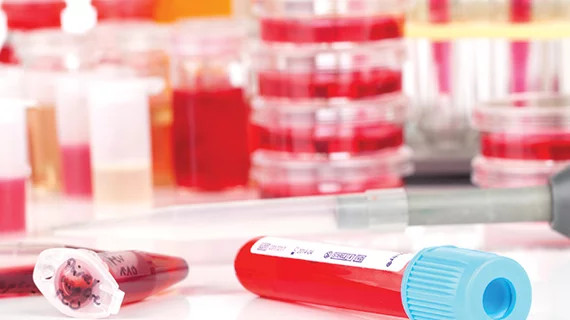Higher concentrations of troponin—even those that were within a “normal range”—signal increased odds of adverse outcomes among outpatients with stable chest pain, suggesting the biomarker test may improve risk stratification and inform management strategies for this common clinical scenario.
James L. Januzzi Jr., MD, and colleagues studied 4,021 stable, symptomatic participants from the PROMISE trial who had suspected coronary artery disease (CAD) and agreed to have their blood sampled. Their median high-sensitivity troponin I (hsTnI) value was 1.6 ng/L, well below the 99th-percentile reference limit of 6 ng/L which represented the top of the “normal range.”
Still, the authors observed a stepwise increase in the primary outcome of death, acute MI or hospitalization for unstable angina as hsTnI values went up. Patients who experienced one of those events within a year of follow-up had a median hsTnI concentration of 2.1 ng/L, compared to 1.6 ng/L among those who didn’t experience an event. When considering only the patients who died or had a heart attack, the median hsTnI value was 2.4 ng/L.
“When added to the pre-existing findings on troponin and cardiovascular risk prediction, it confirms and extends the conclusion that troponin measurement across the reference range as well as above the reference interval is a powerful predictor of cardiovascular risk,” Paul Collinson, MBBChir, MD, with St. George’s University of London, wrote in a related editorial published Jan. 21 in the Journal of the American College of Cardiology.
“The inference is that serial measurement of cardiac troponin may be a useful tool for monitoring cardiovascular health, with a progressive rise in troponin indicating increasing risk.”
Managing patients with stable chest pain is often challenging, according to Januzzi et al., because this population encompasses individuals with a broad range of risk. Stress testing with or without imaging and CT angiography (CTA) can be used to detect obstructive CAD, but these methods are limited by their availability, cost and exposure to ionizing radiation.
Blood tests measuring troponin, which are available in increasingly sensitive assays, are one potential solution to quantifying risk in this population—but troponin has previously only been evaluated as a prognostic tool in groups with established CAD.
Yet, the authors’ new study in JACC found a highly sensitive assay—which is currently unapproved by regulatory authorities—detected a measurable hsTnI concentration in almost 99 percent of stable outpatients.
In addition, each log increase in the hsTnI interquartile range was associated with a 54 percent greater chance of death, acute MI or hospitalization for unstable angina at one year, and a 52 percent greater chance of death or acute MI. The predictive power was strongest for events in the near term, with higher hsTnI values signaling a 2.18-fold increased risk of death or MI at 30 days and a 75 percent increased risk at 90 days.
“Concentrations of hsTnI appeared similarly useful in men and women and were particularly prognostic for near-term events,” wrote Januzzi, with Massachusetts General Hospital in Boston, and co-authors. “We thus not only have linked hsTnI concentrations to the presence and severity of CAD in patients with stable chest symptoms, but also now extend these results to show that hsTnI values in these subjects are prognostic for near-term events.
"Taken together, these results suggest a potential utility for blood-based biomarkers in general, and for more highly sensitive troponin methods in particular, for assessment of stable chest pain syndromes.”
The authors said this study used an unapproved hsTnI assay with greater sensitivity than those used in previous analyses, making the data unique. The developer of that assay, Singulex, partially funded the research.
Given the study design, most patients had well-preserved kidney function, potentially limiting the ability to extrapolate the results to those with renal disease. Other factors to consider, according to the authors, are that results might differ with commercial hsTnI assays, and it remains a challenge to identify a single cutoff value with the most clinical utility.
Further investigations and cost-effectiveness analyses for hsTnI assays are warranted before the test is routinely used to guide the management of patients with suspected CAD, the authors suggested—but their results indicate the technique could separate high-risk individuals from a group with much lower risk.
“It is reasonable to hypothesize that patients with stable chest pain syndromes with relatively higher hsTnI could merit more aggressive diagnostic or therapeutic management,” Januzzi and colleagues wrote. “Besides typical recommendations for higher-risk patients, such as avoidance of tobacco use, exercise prescription, or more aggressive medical management of risk factors, proceeding directly to coronary CTA imaging or invasive angiography may be an option for such patients, although it is premature to make such a recommendation.”

